The Critical Duty line of ammunition is Hornady’s premium line of ammo developed for law enforcement. As many of you know, I spent more than a decade in police work, so I have an acute desire to know what really works and to expose anything that is pure marketing hype.
While I cannot state that these rounds are definitively better than other premium loads from Federal Premium Ammunition, Speer Ammo, Remington or Winchester, I can say that I would pick these to carry over any of the other handgun loads that Hornady currently manufactures – and I think the company makes good ammo across the board.
Hornady specially tailored these rounds to the threats and environments that law enforcement officers encounter. In this review, I will go over each of the current loads as well as give you feedback about how they performed on the range. As time goes on, I will update this page with additional testing data, gel tests and new loads offered in this line.
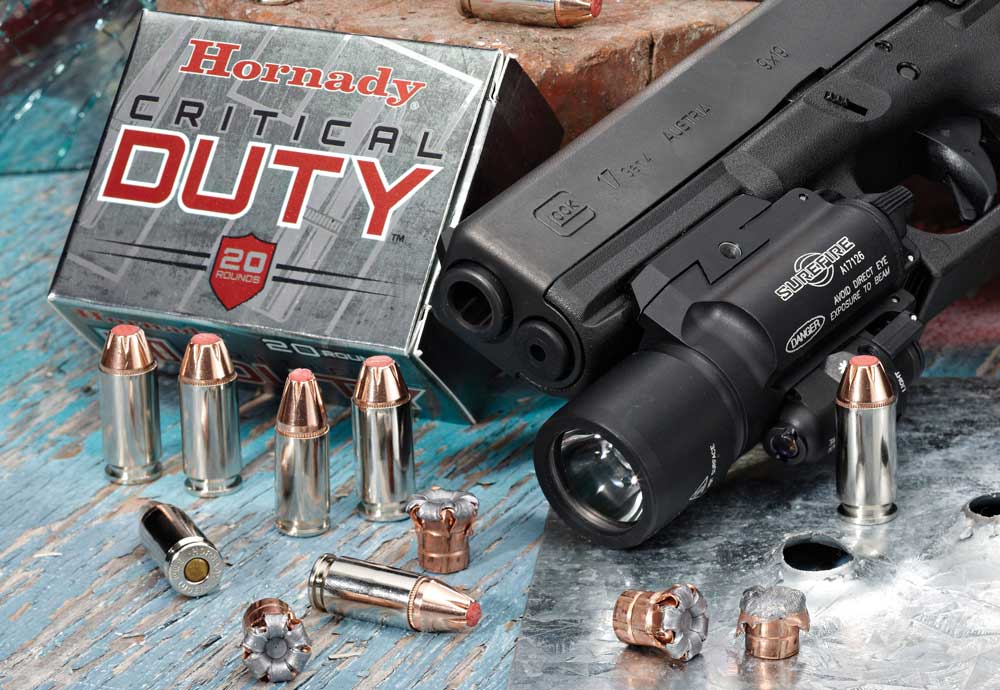
As I explain more about the Critical Duty line, I will also show how it compares to the Critical Defense line so you have a clearer understanding of the two choices. While the Duty rounds will serve armed citizens as well, Hornady offers a different line of ammunition called Critical Defense that is loaded to better suit non-cops in many circumstances.
Background on Critical Duty Ammo
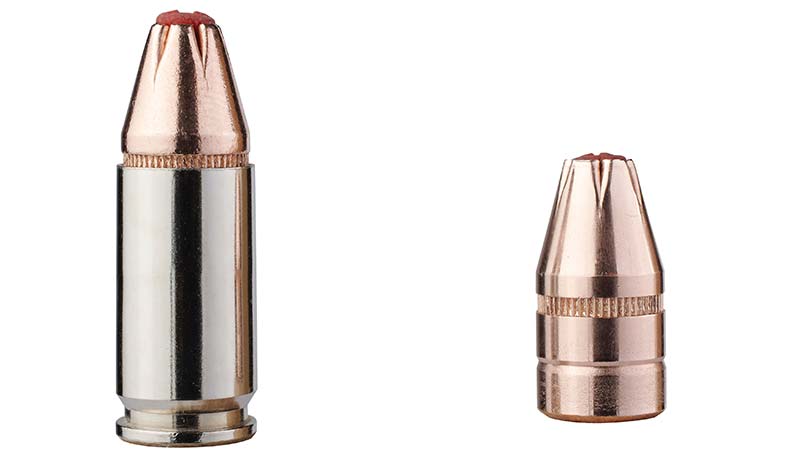
In November of 2011, Hornady announced a new line of law enforcement ammunition called Critical Duty. This new ammo was carefully designed to meet the specific requirements of police use. That is to say, Hornady built the ammo performance envelope around the FBI tests.
The Critical Duty ammo was initially available in two 9mm loads and one .40 S&W load. Since then, the line expanded to include the .45 ACP, 10mm, .357 SIG, and most recently the .357 Magnum. A .380 ACP load has been rumored but has not yet appeared. I would expect that it would be difficult to make a 9×17 load perform to acceptable levels in the FBI tests.
General Design of the Hornady Ammunition
Hornady Critical Duty ammunition uses a FlexLock bullet design that incorporates elements from previous company designs with the intent to perform well in the FBI ammunition testing protocol.
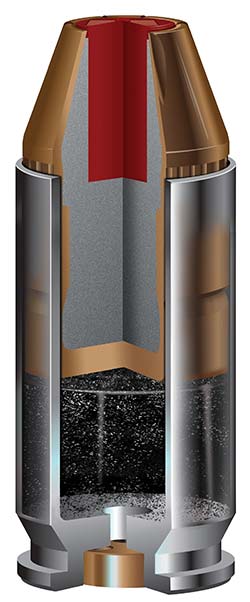
The bullets use the company’s Flex Tip technology, which is a polymer-filled hollowpoint. The Flex Tip prevents the hollowpoint from being filled when passing through clothing or another barrier. Yet, it also helps expansion when striking the target by compressing and putting pressure on the inside of the hollowpoint the same way flesh or a ballistic medium would.
Hornady uses an InterLock band to hold the bullet jacket to the core, rather than using a chemical bonding process often used by other manufacturers. The benefit to this method is that the company can use a heavier, antimony-rich core rather than a soft, pure (or close to pure) lead typically used with bonded bullets. A high antimony lead alloy will allow for deeper penetration when compared to a softer alloy.
The Critical Duty loads featured slightly unusual-for-the-caliber bullet weights. For example, the 9mm loads (both standard pressure and +P) use 135-grain bullets. The .40 S&W load uses a bullet weighing 175 grains. It is possible that Hornady’s use of a polymer plug plus a higher antimony content in the lead alloy is the reason for the unusual bullet weights rather than any engineering decision to develop a non-standard bullet weight.
Critical Duty ammunition use low-flash powders to reduce the blinding of officers who are shooting the rounds in low light conditions. A low flash has the additional benefit of making it harder to pinpoint the officer’s location when bad guys are shooting at him or her.
Rounds use nickel-plated cases. Nickel is typically used to plate premium self-defense ammunition. While I don’t know that it makes a great deal of difference, nickel is a metal with high lubricity. This – in theory – makes the cases easier to extract. Also, nickel is less likely to tarnish or corrode than plain brass when exposed to the weather. Considering how many times an officer is stuck in the rain or snow, this is actually an important consideration.
Hornady seals the primers and case mouth to help prevent moisture penetration.
Hornady gives a brief overview of the ammo in this video:
FBI Performance & Testing
Critical Duty ammo was designed by Hornady to perform well in the FBI testing protocol. The protocol is an arbitrary set of standards developed by the FBI to measure ammunition performance. While I do not think the protocol is proportionally reflective of law enforcement shootings, it does provide a standard by which two ammunition designs can be compared. In reality that is about all any lab test can hope to accomplish.
The FBI protocol and ammo review include shooting the bullets into calibrated ballistic gelatin. Some of the tests include the intermediate barriers of:
- heavy clothing
- drywall
- plywood
- sheet metal
- laminated glass

Hornady states the FlexLock bullets in the Critical Duty line perform very well in the FBI protocols. This is good from a static testing standpoint, but actual performance “on the street” remains to be seen.
Some other ammo lines have performed very well on duty but failed to meet the standards of the FBI protocol. Likewise, a few ammunition lines have been developed for the FBI protocol but had less than stellar results in the real world.
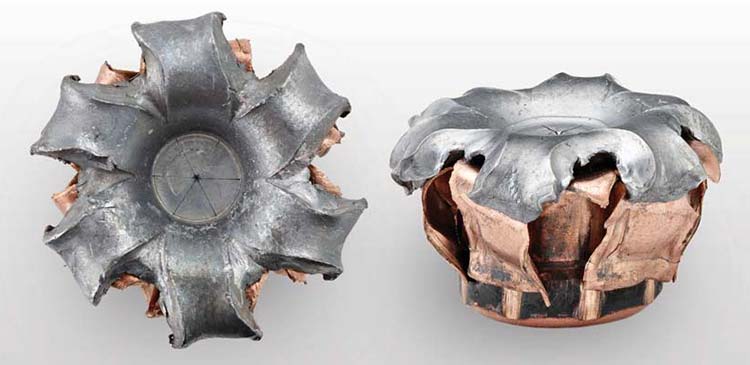
Bare Gelatin Test
| Penetration | Expansion | Recovered Weight | |
| 9mm 135 grain | 15.25″ | .555″ | 99.9% |
| 9mm 135 grain +P | 14.00″ | .597″ | 99.6% |
| .357 Magnum 135 grain | not available | not available | not available |
| .357 SIG 135 grain | 14.00″ | .580″ | 99.0% |
| .40 S&W 175 grain | 13.50″ | .573″ | 99.3% |
| 10mm 175 grain | not available | not available | not available |
| .45 ACP 220 grain +P | 14.00″ | .708″ | 99.0% |
Heavy Clothing Test
| Penetration | Expansion | Recovered Weight | |
| 9mm 135 grain | 15.50″ | .494″ | 99.6% |
| 9mm 135 grain +P | 14.00″ | .597″ | 99.6% |
| .357 Magnum 135 grain | not available | not available | not available |
| .357 SIG 135 grain | 13.50″ | .560″ | 99.0% |
| .40 S&W 175 grain | 14.50″ | .540″ | 99.4% |
| 10mm 175 grain | not available | not available | not available |
| .45 ACP 220 grain +P | 14.43″ | .686″ | 99.1% |
I’m cautiously optimistic about the performance of this ammunition, but I’m simply not familiar with any real-world shootings with it. Even though the ammunition has been on the market for several years, and subjected to more than one independent ammunition review, I simply don’t know how many agencies have adopted the loads.
I am a firm believer that shot placement trumps bullet design. Rapidly putting multiple rounds into vital areas is more likely to stop a fight than the choice of Federal vs. Speer vs. Hornady. However, there are clearly some designs that perform better than others. So, given my druthers, I’d rather rapidly put multiple good hollow points into a target than the same number of cheap FMJs.
In this video, Hornady runs the 9mm +P load through the FBI testing:
The popular Critical Defense line of ammunition is not designed to perform well in the FBI testing protocol. It is engineered for the violent encounters that an armed citizen might find themselves thrust into.
In general, this means that the Critical Duty will be more likely to defeat intermediate barriers and penetrate more deeply than the Critical Defense. That does not suggest one is better than the other, rather, one is more suited for a particular need than the other. Both are quality rounds.
Hornady Critical Duty Loads
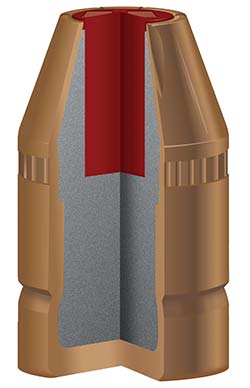
As mentioned elsewhere in this review, there are a number of different loads in the Critical Duty line. They are:
- 9mm
- 9mm +P
- .357 Magnum
- .357 SIG
- .40 S&W
- 10mm
- .45 ACP +P
I detail each of the loads in more detail below.
9x19mm Parabellum
Hornady offers three different loads in 9mm – a standard pressure 135-grain load and +P loads with 124- and 135-grain bullets.
For the standard pressure 135-grain version, Hornady lists the muzzle velocity as 1010 fps. The higher-pressure 135-grain loading has a muzzle velocity of 1110 fps.
The 124-grain +P Critical Duty load is a bit faster with a muzzle velocity of 1,175 fps.
Hornady developed the specs using a 4″ test barrel.
I found all loads to be reasonably accurate and soft-recoiling. Even the +P loads didn’t seem to jump as much as some other +P ammo. This might vary depending on the gun you shoot.
All rounds shot 100% reliably in each of the firearms tested.
9mm 135 gr standard pressure
| Barrel Length | Velocity | Energy | |
| Bersa BP9CC | 3.3″ | 961 fps | 277 ft-lbs |
| Black Creek Precision AR Pistol | 10.5″ | 1,084 fps | 352 ft-lbs |
| CZ P-07 Duty | 3.8″ | 944 fps | 267 ft-lbs |
| Diamondback DB9 | 3.0″ | 932 fps | 260 ft-lbs |
| DoubleTap pocket pistol | 3.0″ | 868 fps | 226 ft-lbs |
| Glock 43 | 3.4″ | 960 fps | 276 ft-lbs |
| HK VP9 | 4.1″ | 962 fps | 277 ft-lbs |
| Remington R-51 | 3.4″ | 954 fps | 273 ft-lbs |
| Smith & Wesson M&P Shield | 3.1″ | 929 fps | 259 ft-lbs |
| Springfield XD-S 4.0 | 4.0″ | 1,000 fps | 300 ft-lbs |
| Taurus 905 (revolver) | 2.0″ | 941 fps | 265 ft-lbs |
| Taurus G3c TORO | 3.2″ | 961 fps | 277 ft-lbs |
| Walther PPS | 3.2″ | 950 fps | 270 ft-lbs |
I’ve often found that Hornady loads are a little slower out of factory guns than the factory published numbers. If you look at the table above, you will see that the velocities I measured were slower than the published spec. That is to be expected with the shorter barreled weapons.
I measured velocities with a Competition Electronics ProChrono Digital Chronograph that was set up approximately 15′ from the muzzle, and the numbers represent an average of five-shots. Hornady’s specs may be more accurate to the muzzle velocity, and are likely to be measured with more precise equipment.
9mm 135 gr +P
| Barrel Length | Velocity | Energy | |
| Bersa BP9CC | 3.3″ | 1,063 fps | 339 ft-lbs |
| Black Creek Precision AR Pistol | 10.5″ | 1,213 fps | 441 ft-lbs |
| CZ P-07 Duty | 3.8″ | 1,075 fps | 346 ft-lbs |
| Dark Storm Industries DS-9 | 16.0″ | 1,260 fps | 330 ft-lbs |
| Glock 17 in CAA Carbine Kit | 16.0 | 1,412 fps | 598 ft-lbs |
| Glock 43 | 3.4″ | 1,049 fps | 330 ft-lbs |
| HK VP9 | 4.1″ | 1,069 fps | 342 ft-lbs |
| Kahr CM9 | 3.0″ | 994 fps | 296 ft-lbs |
| Remington R51 | 3.4″ | 1,058 fps | 335 ft-lbs |
| SIG SAUER P290 RS | 2.9″ | 989 fps | 293 ft-lbs |
| Smith & Wesson M&P Shield | 3.1″ | 1,010 fps | 306 ft-lbs |
| Steyr S9-A1 | 3.6″ | 1,047 fps | 329 ft-lbs |
| Taurus 905 (revolver) | 2.0″ | 1,065 fps | 340 ft-lbs |
| Walther PPS | 3.2″ | 1,049 fps | 330 ft-lbs |
The higher-pressure 9mm load measurably increased velocity. The increase on the company numbers is 100 fps, and that was closely reflected in the numbers I found. For example, there was a 107 fps increase in the VP9, an 81 fps increase in the Shield and a 104 fps increase with the Remington R51.
Critical Duty Recall
In July of 2014, Hornady issued a recall notice for lot # 3141635 of the Critical Duty 9mm 135 gr +P ammunition. This ammo may have light or no powder charge. In other words, if an officer has loaded with ammo from this lot, none of it may work. What a nightmare.
The bad ammo shipped between June 5 and July 16, 2014. If you think you’ve got some of this ammo, contact Hornady immediately.
.357 Magnum
New for 2015 is the .357 Magnum load. This load was introduced at the 2014 NASGW show and should be ready for the general public in early 2015. I have not had any of this to test yet, but when I can get some, I will post the results here.
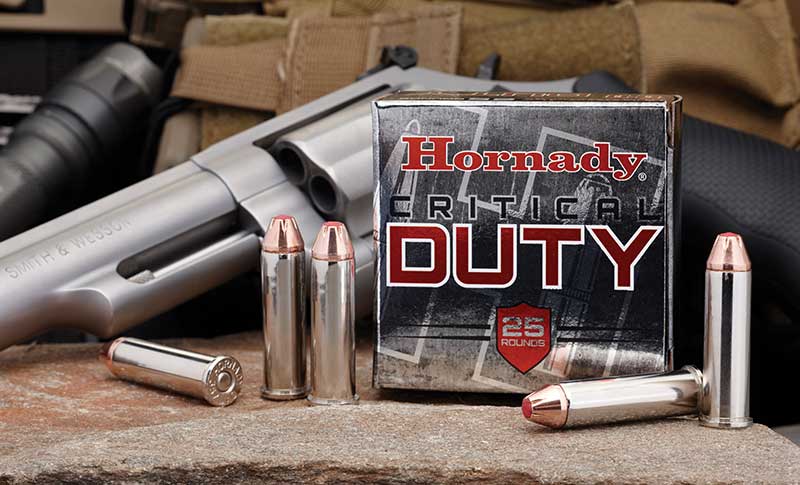
From an 8″ test barrel, Hornady rates this load at 1275 fps. Hornady is using a 135 grain bullet, so the muzzle energy is listed as 487 ft-lbs.
I am a bit surprised to see the company develop a .357 Magnum load in the Critical Duty line. I imagine there are very few Magnum revolvers being carried by police officers in the 21st Century. Of those, I suspect that most are carrying a snubnose .357 as a back-up gun. Even more are probably carrying a .38 Special as a BUG, which is one caliber not represented in this line.
Dropping from an 8″ test barrel to a 2″ barreled J-frame is likely to drop the velocity a lot. Fortunately, the bullet design will help ensure expansion.
.357 SIG
Like it or hate it, there is little doubt that the .357 SIG is a high energy pistol cartridge. However, the Critical Duty load is slightly different from other loads from the major competitors in the space.
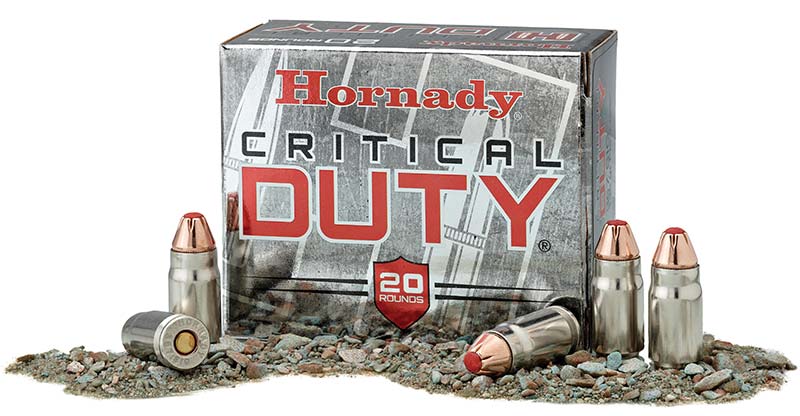
The .357 SIG load uses a 135 grain FlexLock bullet similar to the 9mm rounds. This is heavier than many of the .357 SIG rounds, which are typically 125 grains in weight. The bullet weight may, in part, contribute to a relatively low muzzle velocity (for a .357 SIG) of 1225 fps. The round produces 450 ft-lbs of energy.
By comparison, the Speer Gold Dot runs a 125 grain bullet at 1375 fps for 525 ft-lbs of energy. Likewise, the Winchester PDX1 is moving a 125 grain bullet at 1350 fps for 506 ft-lbs. Similar numbers can be seen from Federal, Corbon and others.
For this particular gun, the Glock 31 with a 4.5″ barrel was used for Hornady’s testing. The other brands likely used test barrels of 4″ to 5″ in length.
To date, I have not tested any of this ammo. When I do, I will post the results and my thoughts here.
.40 S&W
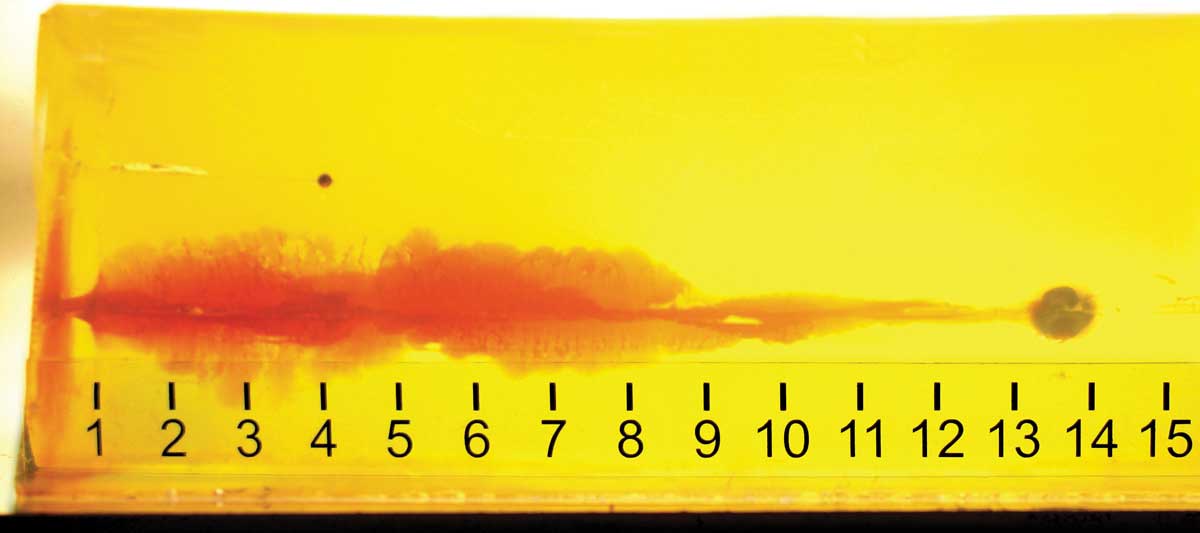
Given the proliferation of .40-caliber pistols in the hands of law enforcement, I would expect that the 175 grain Hornady Critical Duty load will sell very well for the company.
Slightly lighter than the original 180 gr bullet weight offering when the first .40 S&W guns were announced in 1990, the bullets are heavier than the popular 155 grain bullets frequently carried by cops.
In my testing, this load was completely reliable with no problems of any kind.
| Barrel Length | Velocity | Energy | |
| Bersa BP40CC | 3.3″ | 941 fps | 344 ft-lbs |
| Glock 27, Gen3 | 3.4″ | 935 fps | 340ft-lbs |
| Rock River LAR-40 | 16.0″ | 1,032 fps | 414 ft-lbs |
| Smith & Wesson Model 610 | 4.0″ | 982 fps | 375 ft-lbs |
| Walther PPX | 4.0″ | 951 fps | 351 ft-lbs |
Hornady rates this load at 1010 fps at the muzzle of a 4″ test barrel. My testing shows a slightly reduced velocity with the chrono set up at about 15′ from the muzzle. For further comparison, Hornady shows the factory data as 948 fps for this load at 50 yards.
I personally felt that this load’s recoil was in line with any other .40 load. It is a little harsher than a 9mm, but not as bad as some of the more stout .40 loads.
10mm Auto
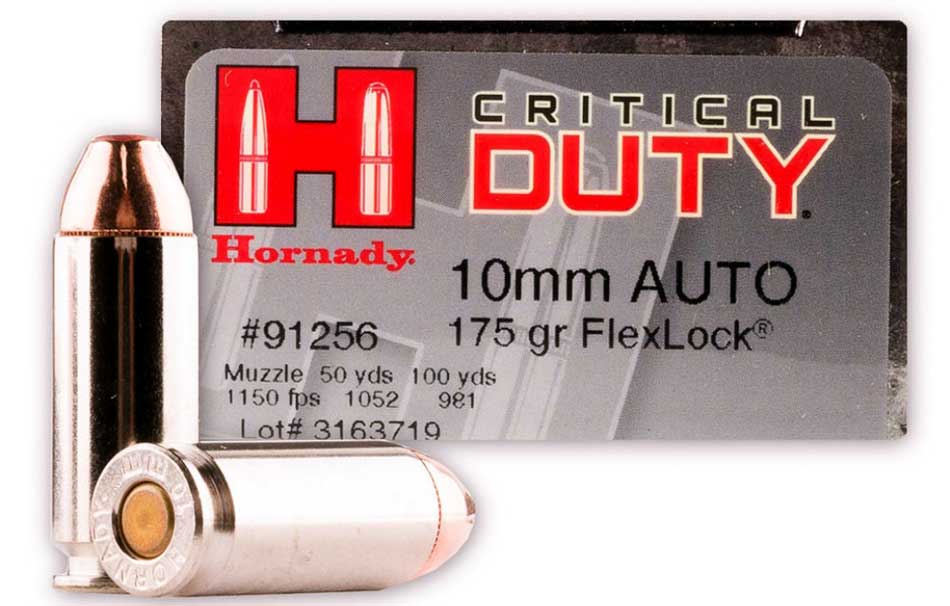
The 10mm load uses the same 175 grain bullet that is used in the .40 S&W. However, it pumps up the velocity to 1200 fps. I expect this 10mm Hornady Critical Duty load to be quite popular with enthusiasts of this cartridge. I don’t know of any departments that issue or mandate the 10mm.
Originally, this load is listed as a “Cabella’s Exclusive.” Cabella’s is a well known outdoor store, and not the first place I would think of for law enforcement gear. I have not yet tested this ammo load.
.45 ACP
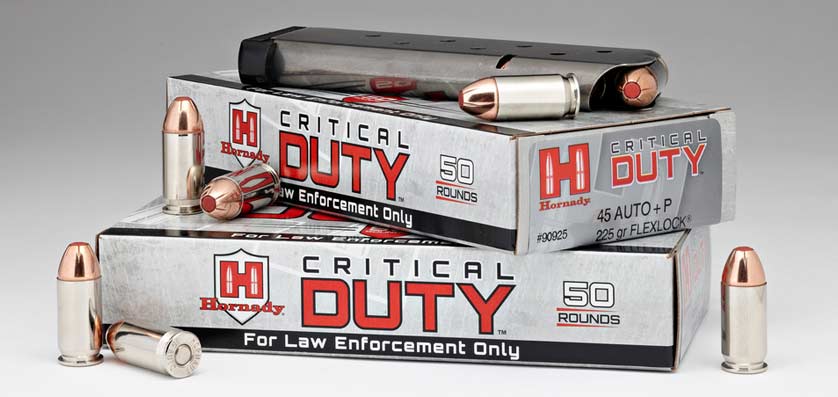
The Hornady Critical Duty .45 ACP +P load uses a 220 grain FlexLock bullet. Most frequently, I’ve seen standard pressure 230 grain loads and +P pressure 185 grain loads in .45. A high pressure, heavy bullet load is relatively uncommon – but not unheard of.
I found the recoil was pretty mild – even for a +P rated load. I’ve always found the .45 to have less felt recoil than the .40 S&W, and it was true with these loads as well.
Accuracy was very good with this load. Also, it ran 100% in the guns I tested.
| Barrel Length | Velocity | Energy | |
| Colt 1911 (circa 1972) | 5.0″ | 967 fps | 457 ft-lbs |
| Desert Eagle 1911-U | 3.0″ | 883 fps | 381 ft-lbs |
| Girsan MC 1911 C T | 4.4″ | 953 fps | 444 ft-lbs |
| Glock 21 SF | 4.6″ | 974 fps | 463 ft-lbs |
| STI Escort | 3.2″ | 890 fps | 387 ft-lbs |
| Wilson Combat X-Tac Supergrade Pro | 4.0″ | 917 fps | 411 ft-lbs |
Hornady lists this load at 975 fps from a 5″ test barrel. With the Glock 21 SF, a 4.6″ barreled pistol, I measured 974 fps at 15′ from the muzzle. That’s pretty darn close to the factory specs.
I’ve got additional testing coming up with another short barrel 1911 and a full length Colt 1911. As soon as I have the numbers from those tests, I will post them here.
This is the promotional video released by Hornady about the .45 ACP load:
Final Thoughts on the Critical Duty Handgun Ammo
There are a wide range of self-defense ammo choices on the market. Many of them are very good, while a few should be avoided. The ballistics of each is unique. The Hornady Critical Duty appears to be a good pick for stopping bad guys.
I tend to default to the Speer Gold Dot and Federal HST for my carry ammo. I’ve seen what this defensive ammo can do in real world shootings, and it has always been a reliable performer in all of my handguns.
However, I would not feel at a disadvantage if I was carrying the Critical Duty load. There are a number of things I really like about this ammo, and the bullet design is one of them. The gel testing completed at Pocket Guns & Gear and other locations show these bullets tend to give good expansion across a range of velocities.
One thing to keep in mind – this is not the same ammo as the Hornady Critical Defense ammunition.
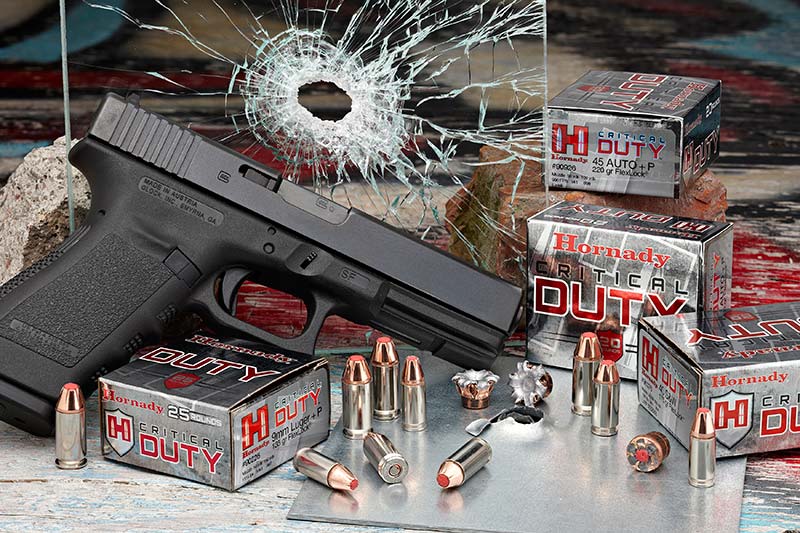
If you are working for a police department, chances are you are required to carry a specific load. For agencies considering an ammunition change, Critical Duty deserves a look. Hornady offers ballistic demonstrations that I highly recommend you attend to see this stuff first hand.
Do police departments use Hornady Critical Duty?
Yes, some police departments issue the Hornady Critical Duty cartridges for uniformed patrol officers. However, Speer Gold Dot and Federal HST tend to be the most commonly encountered duty ammunition issued in local law enforcement agencies based on informal studies conducted.
Does the FBI use Hornady Critical Duty?
Yes. The Federal Bureau of Investigations (FBI) issues the Hornady Critical Duty 9mm +P 135-gr. load for duty carry. The cartridges use the medium weight 135-grain FlexLock bullet that performs well in both organic and hard inorganic materials.
Last update: June 15, 2024

3 replies on “Hornady Critical Duty Ammo Review [Updated]”
re: The Critical Defense line of ammunition is Hornady’s premium line of ammo developed for law enforcement.
That’s not the way to start an article about Critical Duty.
Well, that’s embarrassing. Thanks for the note – the article has been corrected.
-Richard
I Tested The C.D. 45 acp in The Glock M30S Which Has a 3.5 ” Barrel and Fired into Water Soaked Magazine ! The Result Were Great as it Penetrated Over 12 ” and Expansion Was Excellent Each Time